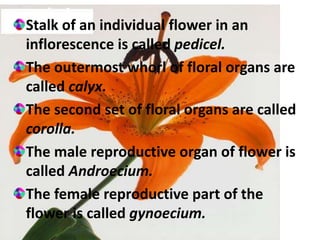structure of flower
- 2. SUBMITTEDBY HARITHA K A NATURAL SCIENCE REG NO: 18114383008 SUBMITTEDTO SOYA .P LECTURER IN NATURAL SCIENCE SUBMITTED ON 15/10/15
- 4. Flowers are beautiful and sweet smelling. we use certain fragrant and colourful flowers for adorning hair and for other decorations. many flowers have in them nectar too. Flowers are the reproductive structure of a flowering plant. Flower is a modified shoot. Specialized for sexual reproduction.
- 5. A flower consist of a very shot axis, called thalamus. Arranged on the thalamus, one above the other, are the floral whorls. Typically, flower has four floral whorls. Namely from base to top,calyx,corolla,androecium,gynoecium or pistil. Base of the flower called receptacle.
- 6. Stalk of an individual flower in an inflorescence is called pedicel. The outermost whorl of floral organs are called calyx. The second set of floral organs are called corolla. The male reproductive organ of flower is called Androecium. The female reproductive part of the flower is called gynoecium.
- 8. Calyx constitutes the outermost whorl of floral organs. Its component parts are the sepals. Sepals are usually green in colour. Enclose the rest of the flower in the bad stage, however they can be absent or prominent and petal like in some species.
- 9. Corolla constitutes the second set of floral organs. It is situated in between the calyx and is usually composed of single whorl of petals. Petals are generally thin, brightly coloured and some times sweet smelling to attract insects that help the process pollination.
- 11. Androecium is the male sex organ in flower. It is made up of a number of sramens. The slender stem like part of the stamen is called filament and the bulged tip is anther. The anthers are seen in the centre of the flower. The pollen from the anthers of one flower is transferred to the stigma of another flower through wind or by animal, especially insects.
- 13. Gynoecium is the female sex organ in flower. Each gynoecium is formed of one or more carpels. Gynoecium consist of stigma, style and ovary. The carpel or multiple fused carpels forms a hollow structure called an ovary. Ovary produces ovules. Ovules are found inside the ovary.















